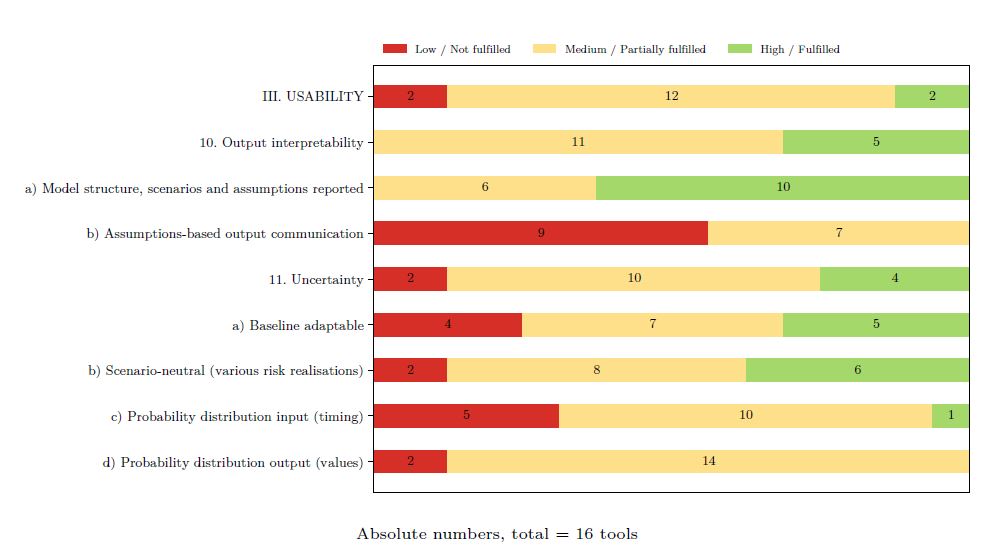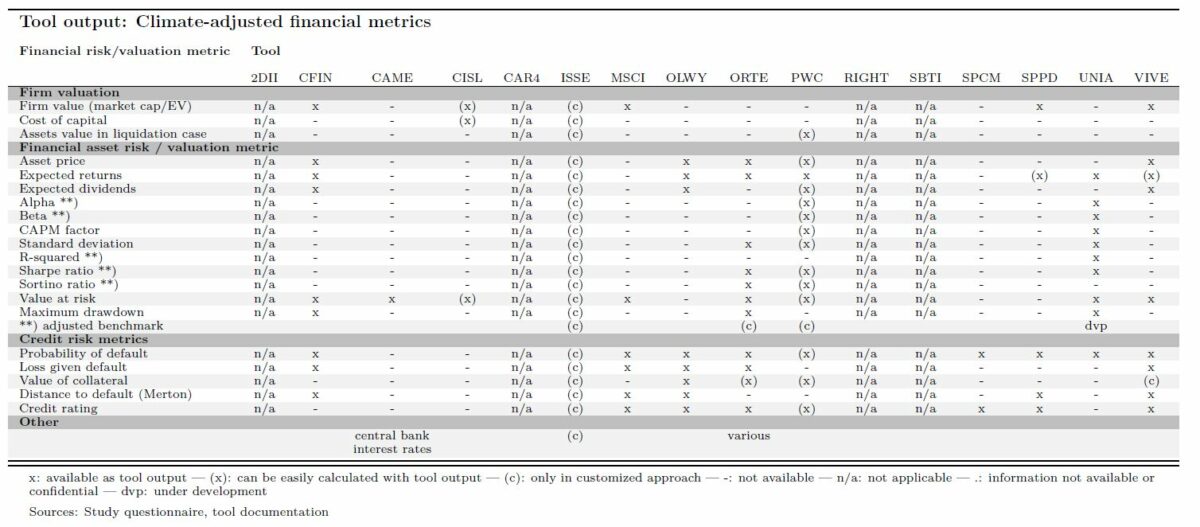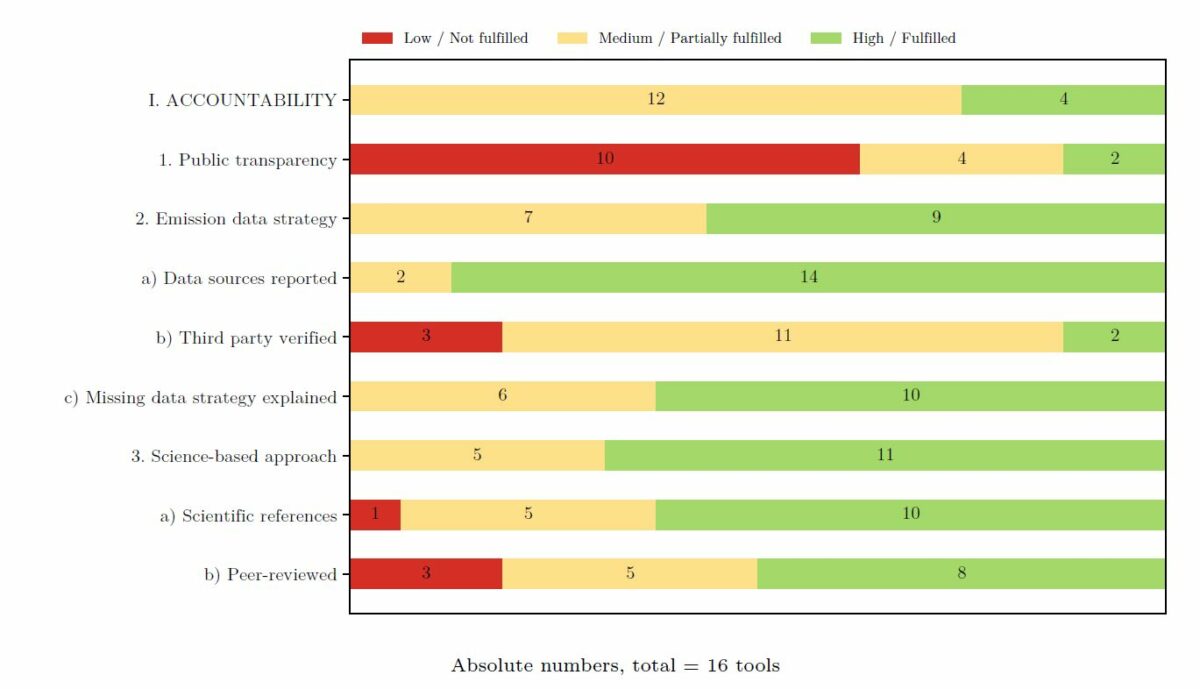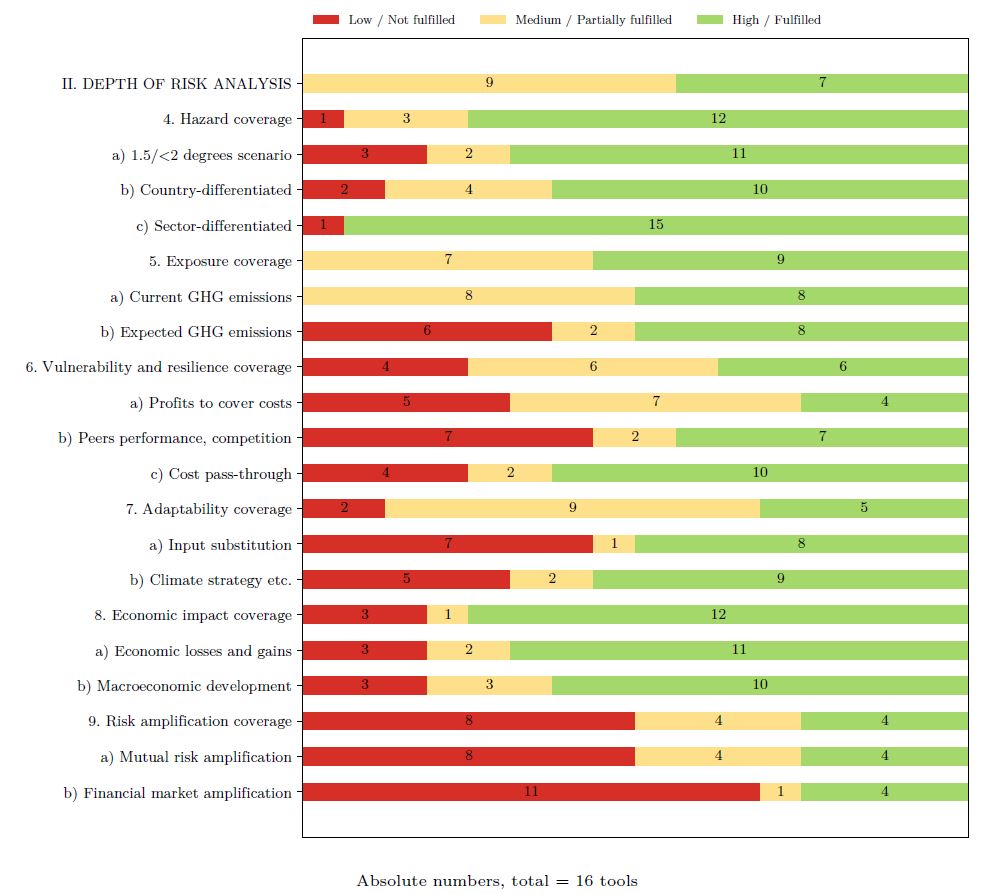INSIGHT by Julia Anna Bingler (ETH Zurich) and Chiara Colesanti Senni (CEP) | Updated on September 24, 2020

Julia Anna Bingler
[caption id="attachment_3112" align="alignright" width="200"] Chiara Colesanti Senni[/caption] It is time for joint assessment principles, standardised disclosure templates, and harmonized tool documentation. Navigating your way through climate risk analysis is challenging. Yet, it is indispensable. It is challenging due to the multitude of tools and approaches, which continue to pop up in academia, by financial service providers, and NGOs. It is also challenging since tools are often not well reported. And it is challenging because understanding the tools requires knowledge of multiple disciplines: The complexity of financial climate risks means to translate insights from climate science and climate modelling into micro-and macroeconomic impacts, and eventually into financially decision-relevant indicators. These challenges need to be overcome. The good news is: They can be overcome.Taking action is urgent: Climate-related financial risks are of increasing concern to investors and financial supervision. They might even have the potential to trigger the next systemic financial crisis, as recently stated by the Bank for International Settlements. Understanding the so-called Green Swan risks should be a key priority in financial decision-making and supervision.In practice, when trying to understand and assess these risks, most actors use one of the climate risk analysis tools available. This means that these tools have considerable influence on firms’ climate risk assessment and management. Until today, there is no commonly agreed standard on how to ensure high quality, comparable, and meaningful results. Regulators have insofar been hesitant in regulating this new field. On the one hand, thiscontributed to the lack of standardization, which also implies higher information and search costs for firms. On the other hand, this fosters innovation.It is indeed not useful to prescribe specific methodologies and approaches. Climate risk analysis is an inherently uncertain endeavour, and the multiple approaches and methodologies simply account for this fact. However, to ensure that climate risk disclosures are of high quality, comparable and decision-relevant for investors and financial supervision, and to enable properly informed internal climate risk management, climate risk analysis needs common standards. This is one of the main findings of our recently published working paper (Bingler, Colesanti Senni 2020: Taming the Green Swan: How to improve climate-related financial risk assessments. CER-ETH Economics Working Paper Series 20/340), where we analyse 16 climate transition risk tools by aid of descriptive and criteria-based analysis.
Chiara Colesanti Senni[/caption] It is time for joint assessment principles, standardised disclosure templates, and harmonized tool documentation. Navigating your way through climate risk analysis is challenging. Yet, it is indispensable. It is challenging due to the multitude of tools and approaches, which continue to pop up in academia, by financial service providers, and NGOs. It is also challenging since tools are often not well reported. And it is challenging because understanding the tools requires knowledge of multiple disciplines: The complexity of financial climate risks means to translate insights from climate science and climate modelling into micro-and macroeconomic impacts, and eventually into financially decision-relevant indicators. These challenges need to be overcome. The good news is: They can be overcome.Taking action is urgent: Climate-related financial risks are of increasing concern to investors and financial supervision. They might even have the potential to trigger the next systemic financial crisis, as recently stated by the Bank for International Settlements. Understanding the so-called Green Swan risks should be a key priority in financial decision-making and supervision.In practice, when trying to understand and assess these risks, most actors use one of the climate risk analysis tools available. This means that these tools have considerable influence on firms’ climate risk assessment and management. Until today, there is no commonly agreed standard on how to ensure high quality, comparable, and meaningful results. Regulators have insofar been hesitant in regulating this new field. On the one hand, thiscontributed to the lack of standardization, which also implies higher information and search costs for firms. On the other hand, this fosters innovation.It is indeed not useful to prescribe specific methodologies and approaches. Climate risk analysis is an inherently uncertain endeavour, and the multiple approaches and methodologies simply account for this fact. However, to ensure that climate risk disclosures are of high quality, comparable and decision-relevant for investors and financial supervision, and to enable properly informed internal climate risk management, climate risk analysis needs common standards. This is one of the main findings of our recently published working paper (Bingler, Colesanti Senni 2020: Taming the Green Swan: How to improve climate-related financial risk assessments. CER-ETH Economics Working Paper Series 20/340), where we analyse 16 climate transition risk tools by aid of descriptive and criteria-based analysis.  Analysis results for each tool and detailed descriptions of each tool are available in the paper.[/caption]
Analysis results for each tool and detailed descriptions of each tool are available in the paper.[/caption]
 Chiara Colesanti Senni[/caption] It is time for joint assessment principles, standardised disclosure templates, and harmonized tool documentation. Navigating your way through climate risk analysis is challenging. Yet, it is indispensable. It is challenging due to the multitude of tools and approaches, which continue to pop up in academia, by financial service providers, and NGOs. It is also challenging since tools are often not well reported. And it is challenging because understanding the tools requires knowledge of multiple disciplines: The complexity of financial climate risks means to translate insights from climate science and climate modelling into micro-and macroeconomic impacts, and eventually into financially decision-relevant indicators. These challenges need to be overcome. The good news is: They can be overcome.Taking action is urgent: Climate-related financial risks are of increasing concern to investors and financial supervision. They might even have the potential to trigger the next systemic financial crisis, as recently stated by the Bank for International Settlements. Understanding the so-called Green Swan risks should be a key priority in financial decision-making and supervision.In practice, when trying to understand and assess these risks, most actors use one of the climate risk analysis tools available. This means that these tools have considerable influence on firms’ climate risk assessment and management. Until today, there is no commonly agreed standard on how to ensure high quality, comparable, and meaningful results. Regulators have insofar been hesitant in regulating this new field. On the one hand, thiscontributed to the lack of standardization, which also implies higher information and search costs for firms. On the other hand, this fosters innovation.It is indeed not useful to prescribe specific methodologies and approaches. Climate risk analysis is an inherently uncertain endeavour, and the multiple approaches and methodologies simply account for this fact. However, to ensure that climate risk disclosures are of high quality, comparable and decision-relevant for investors and financial supervision, and to enable properly informed internal climate risk management, climate risk analysis needs common standards. This is one of the main findings of our recently published working paper (Bingler, Colesanti Senni 2020: Taming the Green Swan: How to improve climate-related financial risk assessments. CER-ETH Economics Working Paper Series 20/340), where we analyse 16 climate transition risk tools by aid of descriptive and criteria-based analysis.
Chiara Colesanti Senni[/caption] It is time for joint assessment principles, standardised disclosure templates, and harmonized tool documentation. Navigating your way through climate risk analysis is challenging. Yet, it is indispensable. It is challenging due to the multitude of tools and approaches, which continue to pop up in academia, by financial service providers, and NGOs. It is also challenging since tools are often not well reported. And it is challenging because understanding the tools requires knowledge of multiple disciplines: The complexity of financial climate risks means to translate insights from climate science and climate modelling into micro-and macroeconomic impacts, and eventually into financially decision-relevant indicators. These challenges need to be overcome. The good news is: They can be overcome.Taking action is urgent: Climate-related financial risks are of increasing concern to investors and financial supervision. They might even have the potential to trigger the next systemic financial crisis, as recently stated by the Bank for International Settlements. Understanding the so-called Green Swan risks should be a key priority in financial decision-making and supervision.In practice, when trying to understand and assess these risks, most actors use one of the climate risk analysis tools available. This means that these tools have considerable influence on firms’ climate risk assessment and management. Until today, there is no commonly agreed standard on how to ensure high quality, comparable, and meaningful results. Regulators have insofar been hesitant in regulating this new field. On the one hand, thiscontributed to the lack of standardization, which also implies higher information and search costs for firms. On the other hand, this fosters innovation.It is indeed not useful to prescribe specific methodologies and approaches. Climate risk analysis is an inherently uncertain endeavour, and the multiple approaches and methodologies simply account for this fact. However, to ensure that climate risk disclosures are of high quality, comparable and decision-relevant for investors and financial supervision, and to enable properly informed internal climate risk management, climate risk analysis needs common standards. This is one of the main findings of our recently published working paper (Bingler, Colesanti Senni 2020: Taming the Green Swan: How to improve climate-related financial risk assessments. CER-ETH Economics Working Paper Series 20/340), where we analyse 16 climate transition risk tools by aid of descriptive and criteria-based analysis. Descriptive analysis: The big picture
In the descriptive analysis, we look at the tool’s coverage of risk sources and risk realisations, their coverage of asset classes, the tool input (i.e. climate scenarios) and the tool output (i.e. the climate-adjusted financial risk metrics). Various transition risk analyses are feasible, yet risk interactions are usually not coveredWe focus on the tools’ coverage of various transition risk sources, namely policy risks, technology risks, market upstream risks (i.e. supply chain) and market downstream risks (i.e. demand). The risks materialise either smoothly (ordered transition) or as a shock (disruptive/immediate transition).We find that policy risk is best covered, and that there is always at least one tool available to analyse one of the specific risk sources and realisations. However, few tools cover all analysed risk sources and the interaction among them - despite the fact that the risk sources could mutually reinforce each other. Tool providers should therefore further develop their tools further in this area. Project loans, mortgages and real assets need better coverageWith regards to the coverage of financial assets, we find that, in our tool sample, publicly traded asset classes are significantly better covered than other asset classes. This is thanks to much more standardised data reporting and data availability. On the opposite, project loans, mortgages and real assets are not well covered across the sample, yet – despite the fact that many transition policies have an impact on the payoff structure of individual projects, or target specifically the buildings sector. A broad coverage of various assets within the same methodological framework would enhance comparability of the risk analysis of various asset classes within the same portfolio. Tool users should aim for scenario-neutral tools and use the NGFS reference scenariosMost tools use either the scenarios of various IAMs (Integrated Assessment Models), or the scenarios provided by the WEO (World Energy Outlook) and the ETP (Energy Technology Perspectives) models of the IEA. The IEA models provide relatively granular data, yet come at transparency shortcomings and systematically underestimated the growth of renewable energy sources in the past. The IAMs are in turn criticized with regards to their modelling assumptions, and their generalising approach. However, there are ongoing efforts in the climate modelling community to overcome these issues. The NGFS reference scenarios are an important step into the right direction to ensure higher comparability of results of the various tools. In addition, we find that in any case, scenario neutrality of tools is an important feature. This allows tool providers to keep their tools up to date with the ongoing developments in climate transition risk modelling, and to better account for users’ own assumptions. Financially relevant metrics are in most cases well coveredThe tools in our sample were selected based on their ability to provide financially relevant metrics. The metrics considered determine for example credit risk, the value of a specific financial asset, or the value of the underlying issuer. We find that most tools provide climate-adjusted financial asset metrics (value at risk and expected returns) and credit risk metrics (probability of default and credit rating). Challenges related to calculating a forward-looking climate-adjusted alpha, beta or Sharpe ratio need to be acknowledged. Yet, we also argue that further tool developments should try to find a way to cover these important financial metrics, too.Criteria-based analysis: Inside the box
In order to assess quality, comparability and decision-relevance of the tools, we analyse three dimensions: accountability, depth of risk analysis, and usability, by aid of 11 assessment criteria. The set of criteria can also be used to ease the tool selection process for potential tool users. We show the results for each dimension in the figures below. The results are produced by assigning a score of 0 (low/ not fulfilled), 0.5 (medium / partially fulfilled) and 1 (high/ fulfilled) to each element of each of the 11 criteria (see our paper for more details about the method). Most tools lack accountabilityAcountability ensures that the data input, the tool setup and the output are verifiable and can be critically evaluated by users and external experts in the field. It covers three criteria: Public transparency, emission data strategy, and science-based approach. We find that accountability is an issue for most tools, due to the combination of low transparency of the tools’ specific setup, with the lack of peer-reviewed publications of the tool approaches. In combination with our findings from the usability analysis (see below), we find that standardised publicly available tool documentation templates would be an important step to improve accountability. Depth of risk analysis varies considerablyWith regards to the depth of risk analysis, tool approaches vary considerably. We argue that – based on current risk understandings in climate science - tool users need to be aware that risk can be decomposed in the following elements: hazard, exposure, vulnerability and resilience, adaptability, and impact. In addition, we look at the consideration of risk amplification mechanisms. Most tools in the sample cover hazard and exposure – yet other risk aspects are only partially covered. Tool users need to be aware of the significant variation in the depth of risk analysis, since this has important implications on the correct interpretation of the tool output. We also find that most tools in our sample are not able to assess mutual risk amplification and financial amplification mechanisms. Yet, these would be two very important aspects for risk assessments of financial institutions, given their relatively high exposure to other financial actors, and for micro- and macroprudential financial supervision. Usability requires standardised reporting and probability distribution-based outputUsability relates to interpretability of results, and how tools reflect the climate analysis-inherent uncertainty. We find that it would be highly beneficial if supervisory authorities asked for standardised publicly available tool documentation, to ease the understanding of assumptions and key characteristics of scenarios and the modelling steps. Furthermore, we find that uncertainty would be better reflected in the tool output if all tools generated a probability distribution of various output values based on different input assumptions, instead of a point estimate. In addition, providers should be asked to report the tool output in direct link with the key assumptions in a standardised sentence or template. Furthermore, scenario neutrality is a desirable feature of tools. As argued above, scenario-neutrality ensures that tool users do not need to rely on a given (set of) specifications and scenarios, and that analyses could always reflect the latest state of the art of climate science and climate modelling approaches.[caption id="attachment_3104" align="aligncenter" width="986"] Analysis results for each tool and detailed descriptions of each tool are available in the paper.[/caption]
Analysis results for each tool and detailed descriptions of each tool are available in the paper.[/caption] 







